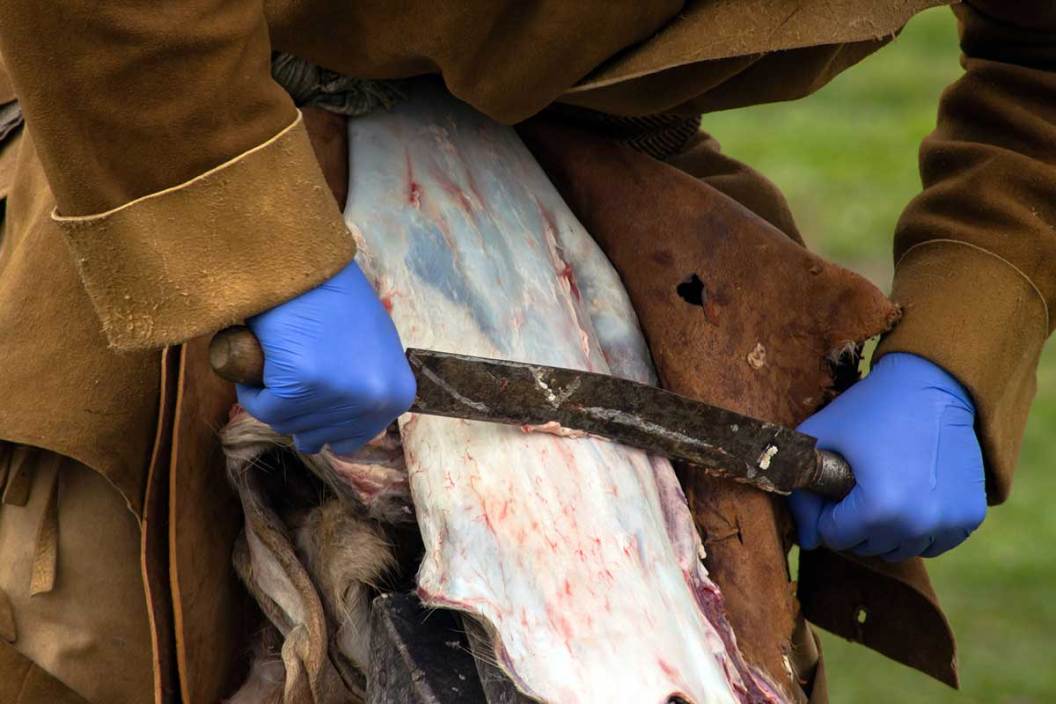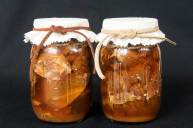Wait! Don't throw those deer hides in the garbage can! Before you toss that heap of hide you just peeled from your deer, why not preserve it for display or use? It's not all hard work, and the payoff to DIY tanning a deer hide is pretty awesome. Buckskin is an excellent example of using every part of the animal, or at least as much as you can. Follow these step-by-step directions and see why the way to tan hides may be a bit easier than you think. A taxidermist could do it, but it doesn't have to be that expensive.
Step 1: Skin Your Deer

Getty: Diane079F
The first thing to do when tanning deer hide is (obviously) to skin your deer. If you happen to be skinning your buck, you might as well go for the entire hide; you can decide later if you want to keep it intact as a "rug" or turn it into functional leather.
The skinning process is lengthy, but we'll assume the hide is off and intact to explain the tanning steps. I like to skin from the tarsals to the jaw for this purpose.
Step 2: Flesh the Hide

Getty: Akchamczuk
With the animal hide now off, it's time to get into the more tedious act of the tanning process: the fleshing. If it's your first time fleshing animal skins, you will find there's a bit of a learning curve. Getting all the flesh and film off the back of the hide is essential because it'll ultimately make for a more successful and cleaner finished product. You can purchase a double-handled fleshing knife. Butt I've always had the best luck with a semi-dull, 6-inch folding hunting knife (notice I said dull; a sharp knife isn't exactly the best tool for this job).
Stretch the hide and secure it. Some recommend staples or nails. I prefer the big metal spring clamps from a hardware store to attach the hide to a cheap part of the flakeboard or plywood. Start in the corner of the flesh side of the hide and work with pressured strokes, holding the knife blade or scraper perpendicular to the coat. You'll see the slime-ish film peel away from the hide, exposing the white fiber deer skin underneath. You don't want to go deeper than this, or you'll cut through the hide.
This part can be time-consuming, but the idea is to wind up with a clean, flesh-free hide. Trust me; it'll pay off in the end. The process can be even more straightforward if you're lucky enough to have a pressure washer. Check out this video to see what I mean:
Step 3: Time to Salt

Diane079F via Getty Images
The next step is adding salt to the skin side and letting it sit. You can keep it right on the board or piece of plywood you used to flesh it on. Go to a supermarket or Walmart and grab a bunch of non-iodized salt (iodized will work but may stain the hide). A 1-pound container shouldn't cost more than a buck. Get about 10 pounds of salt. With the flesh side up, work the salt into the hide, making sure to salt all areas. There's little risk of over-salting here; more is probably better. The purpose is to draw out all moisture and dry the hide out. Leave the hide to sit overnight. The next day there will likely be a pool of fluid sitting on top of the wet salt. Scrape the old salt off and reapply a fresh layer.
The salt essentially preserves the hide. If you aren't going to continue the tanning process now, roll the hide up and freeze it until you're ready to continue. The hide will be dry and stiff from the salt but, once soaked, will become supple again.
Step 4: Choose Your Tanning Solution
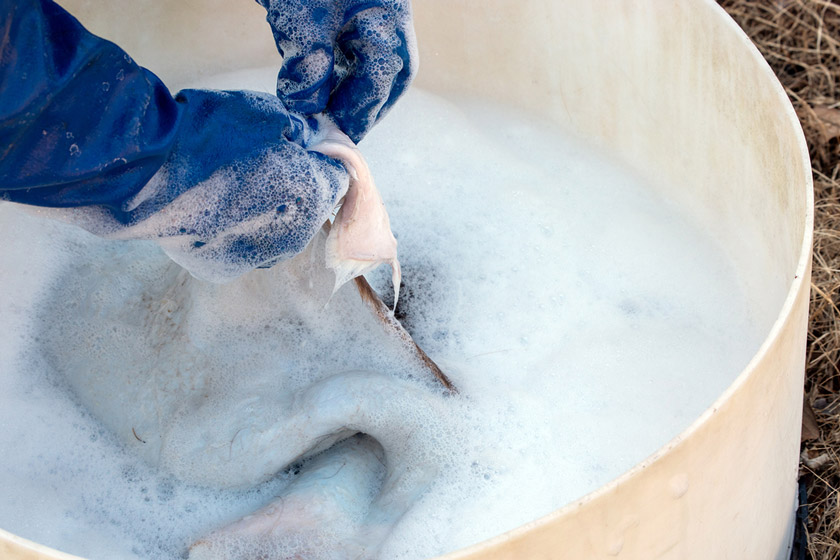
Getty: Diane079F
There are multiple methods to use. You can use the deer's brain solution (if you saved it), an alum solution, or a commercially-prepared tanning solution (probably the most straightforward method). Since the commercial solution isn't costly and is probably the easiest, we'll focus on that method. You can purchase a double pack of Deer Hunter's and Trapper's Hide Tanning Formula from the Sportsman's Guide for less than 20 bucks.
You'll want to clean the hide of any remaining salt and soak it in warm water with a decent amount of soap added for about a day to break down any remaining grease. I prefer a high-quality dish detergent for this process, and a five-gallon bucket usually works. Otherwise, a clean plastic garbage can will do nicely.
While the hide is still damp, work the tanning solution into the non-hair side of the hide (wear rubber gloves). Don't be afraid to use pressure and creative strokes to help the solution penetrate the hide. Focus on your inner Karate Kid for technique.
Step 5: The Waiting Game
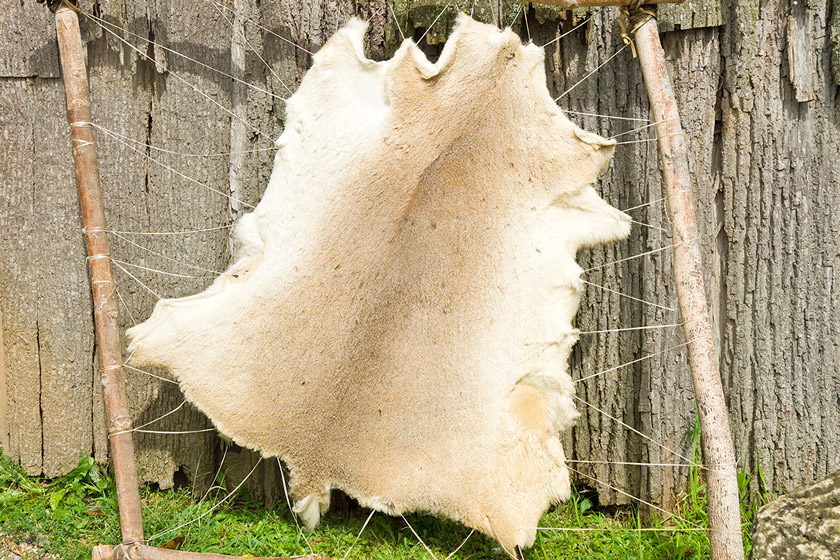
Getty: Chiyacat
With the tanning formula applied, spread the hide out and wait for the curing process to complete the prescribed amount of days (usually about five).
Step 6: Time to Soften Up
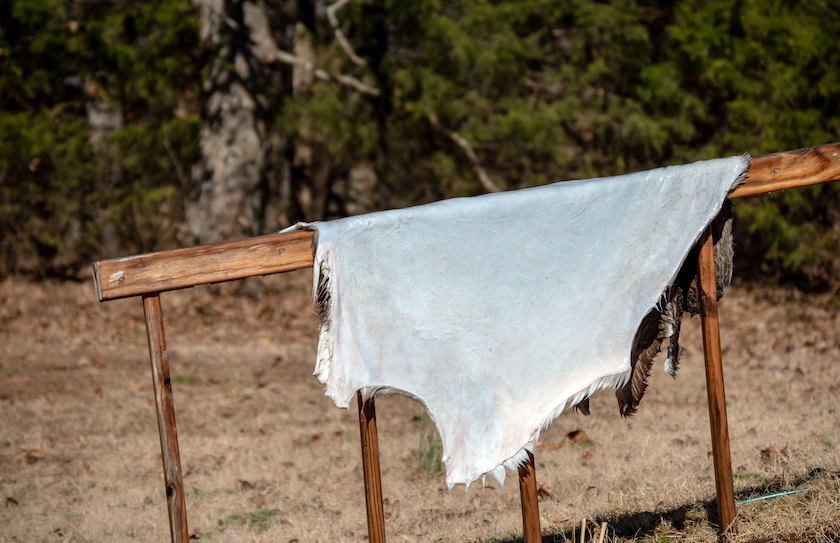
Diane079F via Getty Images
The hide will likely be stiff at the end of this process but don't worry. You can make it as soft as you like. I like to use a spray bottle and moisten the hide with clean water enough to work the fibers loose. A sawhorse or stretched line works well at this point to drape the hide over and drag it back and forth. Repeat this process to your desired liking.
For a suede-type finish, try rubbing the tanned side with a fine-grit sandpaper. That's it! You've finished a nifty bit of taxidermy with your hide! You should now have a soft and usable deer hide to create a wall-hanging rug or become a wearable fashion trend. While not necessarily "quick," learning how to tan a deer hide is pretty straightforward. Before you dump that hide, think about putting it to good use by DIY tanning your deer hide.
Then you'll have your very own buckskin!
This article was originally published on December 12, 2021.
READ MORE: THE AXIS DEER, AND HOW THEY'RE IMPACTING PARTS OF THE UNITED STATES
